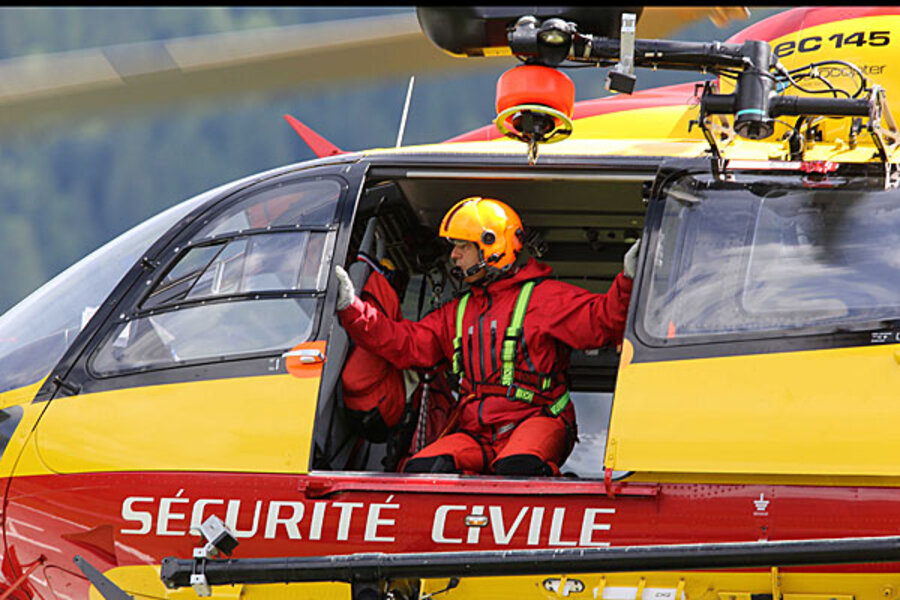Mont Blanc avalanche: 'Scary and tragic'
Loading...
| CHAMONIX, France
They set out before dawn, hoping to conquer a mountaineering classic: Mont Blanc, Western Europe's highest peak. But below the prized summit, a climber is believed to have accidentally caused a slab of ice to snap off, triggering an avalanche Thursday that swept nine climbers to their deaths and injured a dozen others.
As the sheet of snow and ice thundered down the steep slope, several other climbers managed to turn away from the slide in time, regional authorities in Haute-Savoie said.
Two climbers were rescued as emergency crews using dogs and helicopters scoured the churned-up, high-altitude area in a frantic search for the missing. Three Britons, three Germans, two Spaniards and one Swiss climber were among the dead.
Early summer storms left behind heavy snow that combined with high winds to form dangerous overhanging conditions on some of the popular climbing routes around Mont Blanc. Regional authorities had warned climbers to be careful because of an unusually snowy spring.
"It was too dangerous. Everyone has been waiting for something to happen there," said Swedish web designer Michael Andersson, who three days before turned back at roughly the same spot where the avalanche occurred. "But nobody could think it would be this big or this many people."
The dead included the former head of the British Mountaineering Council, Roger Payne, and clients he was leading up the Trois Monts route to the 15,782-foot (4,810-meter) summit of Mont Blanc, the group said on its website.
Initial reports said four climbers were missing, but by nightfall all were accounted for, including two who had turned back before the avalanche. Among the dozen injured was an American, the only known non-European. A seriously injured Swiss citizen was transported to a Swiss hospital.
Current British Mountaineering Council head Dave Turnbull said the mountaineering world was "shocked and saddened" by the loss of Payne, one of Britain's most notable climbers, with expeditions from the Alps to the Himalayas. He and his wife, Julie-Ann Clyma, were both internationally certified mountain guides, based in Leysin, Switzerland.
"It's pretty shocking. I mean, the guiding community here is pretty tight-knit — there's probably about 400 guides in Chamonix. Everybody will have known somebody who was in the hut last night," said Stuart Macdonald, a British guide who directs Avalanche Academy Ltd. in Chamonix and knew Payne.
"Everyone's really feeling it," McDonald said.
The Mont Blanc massif is a popular area for climbers, hikers and tourists but a dangerous one, with dozens dying on it each year. Chamonix, a global epicenter for serious alpine climbing, hosted the first Winter Olympics in 1924.
Police said they were alerted around 5:25 a.m. to the avalanche, which hit a group of climbers who were some 13,100 feet (4,000 meters) high on the north face of Mont Maudit, part of the Mont Blanc range. It was apparently triggered by a climber accidentally breaking loose a 16-inch-thick block of ice that slid down the slope, unleashing the mass of snow, officials said.
Witnesses said that "a climber could have set loose a sheet of ice, and that sheet then pulled down the group of climbers below. I should say the incline was very, very steep on this northern face," Col. Bertrand Francois of the Haute-Savoie police told reporters.
It was not immediately known if that climber was among the dead.
According to tweets from those on the mountain, high winds led to overhanging ice slabs forming on the slope. Several days ago Chamonix saw a monsoon-like downpour, which turned to snow at an altitude of 9,850 feet (3,000 meters).
"The problem is it's been pretty warm and it's been raining as well, so there was ice below," said Andersson, who has lived in the Chamonix area for three years.
French Interior Minister Manuel Valls flew over the avalanche site, describing it as "a particularly spectacular block of ice." He said the climbers appeared to be an experienced group, and that the churned-up snow had made the search particularly difficult.
Jonas Moestrup from the western Danish city of Randers heard about the accident as he was on his way down from Mont Blanc.
"Three days ago, we ascended it. It was shocking to hear, it could easily have been us," he told the Danish news agency Ritzau by telephone. "It is scary and tragic."
Still, he noted the allure of those foreboding, majestic Alpine peaks.
"It's part of the thrill that something can go wrong," he said.
Associated Press writers Angela Charlton in Paris. Anja Niedringhaus in Chamonix, Jan M. Olsen in Copenhagen, Sylvia Hui in London, David Rising in Berlin and Ciaran Giles in Madrid contributed to this report.







